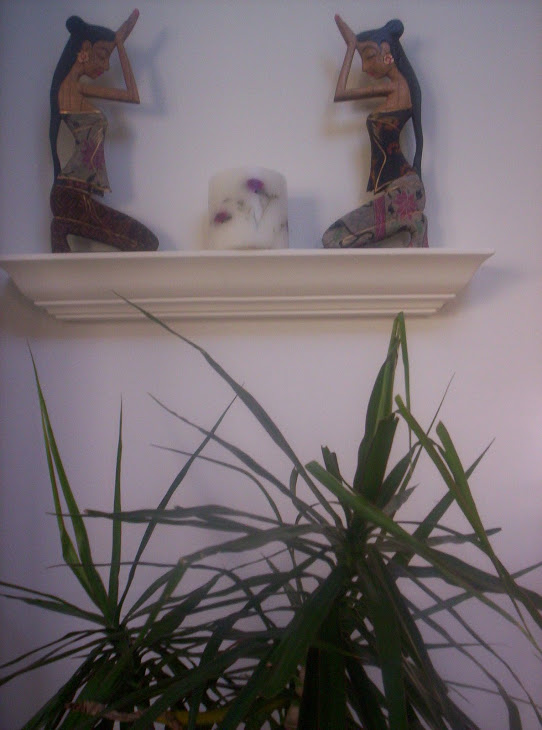This beautiful labyrinth is located on St. Croix in the Virgin Islands at Mt. Washington Plantation near the rain forest where I stayed when I first came to the Island. Here is information about labrinyths in general and this one in particular:
Walking the Labyrinth – There are many ways to walk a
labyrinth. There is no right or wrong way. As you allow yourself to surrender
to the path you will find your own pace and posture. You may pass people; let
others step around you, or stay where you are. More than one person at a time
can be in the center. We are all at a different place on the same
path…journeying toward our center. You do not walk the labyrinth to learn about
the labyrinth to learn about the labyrinth. You walk it to learn about
yourself. Consider everything as a metaphor; be self-observant.
The modern journey calls for self-reflection, a
contemplative practice, and a softening towards oneself and others.
What is a labyrinth?
·
It is an archetypal design – a universal divine
imprint found in all spiritual traditions, including the Buddhist mandala, the
Native American Medicine Wheel and the Jewish Tree of Life
·
It is an outward experience of our inward
journey to our center
·
It is an ancient symbol for reflection and
growth
·
Its circular, spiral-like shape stands for unity
and wholeness
·
It is a walking path of prayer and mediation
·
It is a metaphor for walking the path of life
Who walks a labyrinth?
·
All ages and backgrounds walk a labyrinth
·
A labyrinth is non-denominational and
cross-cultural
What is the difference between a labyrinth and a maze?
·
A labyrinth has a single, circuitous path into
the center
·
The same path exits the center and returns to
the beginning. Thus the entrance becomes the exit
·
There are no tricks or dead ends on a labyrinth
·
There are usually no high walls
·
No thinking is engaged to try and figure out the
path
·
The symbolic, intuitive mind is able to come
forth
How Do I walk a Labyrinth?
There are three stages:
Release and Reflection
·
Upon entering, acknowledge the labyrinth in some
way
·
Release, let go of the details of your life
·
Quiet your mind, become aware of your breath
·
Pay attention to the present moment
·
Meditate on a word, phrase or mantra
·
As other thoughts intrude, let them go and
return to the present moment.
Receive, illumination, union
·
When you reach the center, spend as much time as
you wish
·
The center is a place of contemplation or prayer
·
The center is a place for you to receive what is
there for you
·
Open yourself to joining with the Divine, your
higher power, or the sacred healing forces at work in the world
·
Sit or stand in peace.
·
Meet with your inner self, your soul
Return and Integrate
·
As you leave the center, follow the same path
back to the start
·
Meditate on the insights, gifts, or healing you
received
·
Allow yourself to be renewed as you return to
the world
·
Integrate your experience into your life
Why Walk a Labyrinth?
·
Artistic inspiration
·
Celebrations
·
Grief work
·
Healing
·
Meditation
·
Pastoral care
·
Personal transformation
·
Problem solving
·
Prayer
·
Recovery
·
Spiritual direction
·
Spiritual discussions
·
Staff support
·
Therapy
Where are Labyrinths found?
·
Churches/synagogues
·
Colleges/universities
·
Community parks
·
Corporations
·
Gardens
·
Hospices
·
Hospitals
·
Mental health clinics
·
Nursing homes
·
Prisons
·
Schools
·
Spas
·
Theaters
·
Woods and forest clearings
·
Private residences
How Old is the Labyrinth?
Over 4000 years old
·
Chartres Cathedral in France – built in 1201 –
oldest existing labyrinth in a Christian cathedral
·
Oldest surviving labyrinth – found in rock
carving at Luzzanas in Sardinia (2500-2000 BCE)
·
Oldest European form – Knossos on isle of Crete
·
Earliest surviving labyrinth designs found on
ceramic vessel (1300 BCE) in Syria and on inscribed clay table (c. 1200 BCE)
found in Greece.
·
First labyrinth
built to be walked – in Egypt (c.1800 BCE)
·
Labyrinths are found on all continents
(source: Nancy Ayer – owner/designer and advanced labyrinth
facilitator – stxnancy@gmail.com
Mt. Washington Labyrinth is a medieval Chartres-Style, 7
Circuit Labyrinth
Q. What challenge have you presented yourself? What spiritual practice have you employed to promote your self awareness and development? What stands between you and living your dreams?
Q. What would need to happen for you to get started?
Blessings! Rev. Qiyamah





























